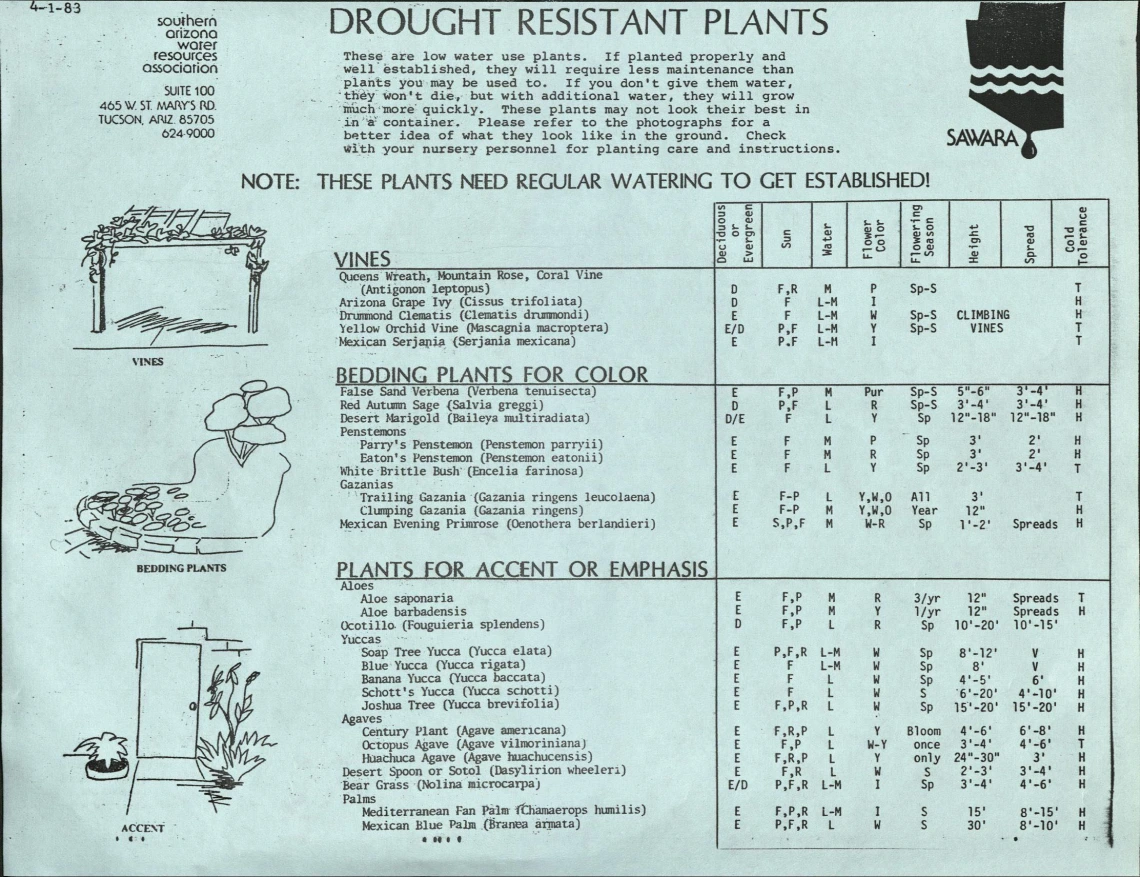Southern Arizona Water Resources Association (SAWARA) records

SAWARA guide to drought-resistant plants, 1983.
Collection dates: 1833-2002 bulk 1982-2000
This collection is comprised of the records of the Southern Arizona Water Resources Association (SAWARA) that document the organization’s educational and outreach efforts about different water issues in Southern Arizona. The collection has been organized into eight series. The bulk of the collection consists of printed material, subject files, photographs, audiovisual material, and meeting minutes.
The
The Southern Arizona Water Resources Association (SAWARA) was formed in 1982 with the specific purpose of informing the Tucson community on water issues and to develop community support for the Central Arizona Project (CAP).
Facing a growing population and a rising demand for water, the City of Tucson voted to raise water rates in 1977. Tucson citizens, however, were not pleased with the decision and voted to recall a number of the council members. The incident brought a newfound appreciation of the finiteness of the supply of groundwater in the Tucson Basin and forced the new elected council to address the issue. Of particular interest was the Central Arizona Project (CAP), which had begun construction in 1973. However, it was not known if CAP water would come to Tucson. In 1981, the Tucson Chamber of Commerce sponsored a large meeting on water issues. One of the recommendations of that meeting was to form an organization to rally the community behind bringing CAP water to Tucson. The following year, a group of business, city, and county government members got together and formed the Southern Arizona Water Resources Association (SAWARA). Their specific purpose was to inform the Tucson community on water issues and to develop community support for the Central Arizona Project. Marybeth Carlisle, a member of the Arizona Water Commission, raised more than $1,000,000 and became the first Executive Director of SAWARA.
Over the next 20 years worked to raise support for CAP and raise water awareness in Southern Arizona. They held workshops and produced publications such as newsletters, billboards, brochures, technical notes, newspaper columns to educate the community and K-12 students. They developed guidelines for Xeriscape landscaping to help conserve water and introduced identification tagging of low water-use plants to nurseries. SAWARA stimulated the modification of local building codes to require the use of water conservation devices. It became the leader of the CAP caucus and its members met frequently with key Arizona and national politicians.
Unfortunately, SAWARA faced funding crises throughout its existence. In 1987, SAWARA cut spending to balance its budget which led to a retrenchment of its outreach activities and made it into more of a policy analysis group. Water conservation activities were handed to Water Resources Research Center handled educational activities and landscaping companies and nurseries took over xeriscape outreach. With the reduction in its educational activities, community support for SAWARA waned. In 1991, the City of Tucson and Pima County began to make contributions to SAWARA, which were increased in 1993-94 so that the City covered one-third of the costs, the County another one-third, and the remaining one-third came from private contributions. However, in 1995 the City and County reduced their contributions substantially and SAWARA was nearly forced to close. Debate over Proposition 200 (Water Consumers Protection Act) brought current and former members of SAWARA into conflict and further threatened the future of the organization. Facing waning financial support, the Board of Directors voted to close SAWARA in February of 2002.
The legacy of SAWARA is still felt today. The Central Arizona Project continues to deliver Colorado River water to Southern Arizona and remains an important resource for water education and conservation.
A collection guide explains what's in a collection. New to using our collections? Learn how to use a collection guide.
Collection guideAccess this collection
Visit us in person to access materials from this collection. Our materials are one-of-a-kind and require special care, so they can’t be checked out or taken home.
How to cite
Learn how to cite and use materials from Special Collections in your research.
